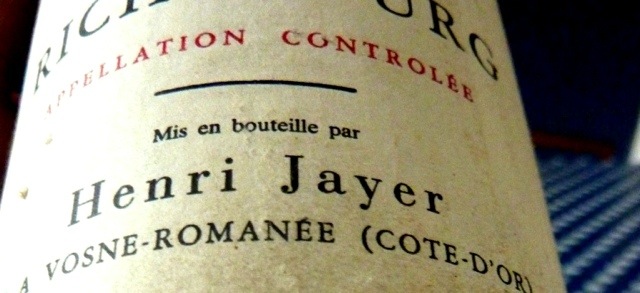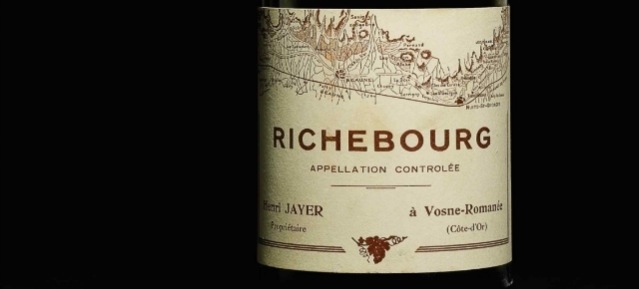One of the most legendary wines in the world is the mighty Richebourg from Henri Jayer – extremely rare and very expensive … and sadly with a lot of fake bottles dominating the market these days.
The Jayer Richebourg was made from the Richebourg holdings of the current Domaine Meo-Camuzet over a period of more than 40 years …. first unknown and bottled by wine merchands, later very popular by collectors and after Henri Jayer stopped making wine it’s fame and glory grew to surreal proportions.
A legendrary wine – so lets take a look at the history and terroir.
The Henry Jayer/Meo-Camuzet plots on Richeborg
As mentioned the Henri Jayer Richebourg was made from vineyards belonging to the current Domaine Meo-Camuzet – the Jayer production of Richebourg presumably began in the mid 1940s and ended in 1987.
Meo-Camuzet own 0.3523 ha on Richebourg located in the top part of the vineyard next to the Cros Parantoux vineyard – see map below.
One plot – 0.0462 ha – is located just below the Jayer/Emmanuel Rouget part of Cros Parantoux in the climate Les Richebourg – the southern part of the Richebourg vineyard. The other plot – 0.3061 ha – is located just north of Cros Parantoux in the climate Les Verroilles ou Richebourg – see map below.
The Henri Jayer era on Richebourg
Henri Jayer began to make wines just after the second world war. The family had quite some vineyards scattered around Vosne, and just after the war he took over the management of the vineyards of Mme. Noirot-Camuzet as he entered into a metayage agreement presumably in 1945. In the early 1950s he also began to develop the Cros Parantoux vineyard – and acquired several plots of this vineyard from the Noirot-Camuzet family.
Mme. Noirot-Camuzet was the daughter of Etienne Camuzet one of the very prominent names in the history of the Vosne-Romanee area. Mme. Noirot passed away in 1959 and the estate was passed on to Jean Meo, the father of the current manager of Domaine Meo-Camuzet.
The metayage agreement between Henri Jayer and the Noirot/Meo-Camuzet family was prolonged several times, and it ended in 1987 – where the last vineyards were returned to Domaine Meo-Camuzet.
The last vintage of Henri Jayer Richebourg was 1987 as the deal with Meo Camuzet was terminated at that point, and Domaine Meo-Camuzet began to produce and bottle the Richebourg themselves. In the vintages 1985 and 1986 a part of the production on Richebourg was sold under the Meo-Camuzet label, so the Jayer production in these vintages was down to one cask of Richebourg. Henri Jayer stayed on as a consultant for Meo-Camuzet in the following years … but his influence seems to have faded in the very early 1990s.
The early history of the Meo Richebourg plots
The main part of the Meo-Camuzet Richebourg is located in the climate Verroilles ou Richeborg.
According to Lavalle1 – Frantin was the only owner on Verroilles ou Richebourg in 1855. The Frantin estate was founded by Antione Vincent Legrand mainly with vineyards bought as “bien nationaux” after the revolution.
The next generation was his daughter Louise Legrand and her husband Jean-Edme Frantin – therefore the name Clos Frantin. Jean-Edme Frantin died in 1863, and after this some of the vineyards were sold of – but it’s somewhat unclear when this happened. The Chanut family bought the Frantin estate in Vosne-Romanee in 1863, but only the village vineyard Clos Frantin is mentioned as a part of this deal. There is no trace of Les Verroilles ou Richebourg in the estate after Philibert Eugene Chanut who died in 1885.
According to Rodier3 – Camuzet was a owner on Verroilles in 1920 and he was also mentioned as a owner by Danguy and Aubertin2 in 1892. The Domaine Camuzet was however founded in the beginning of the twentieth century so it appears that Etienne Camuzet owned these vineyards before the domaine itself was established. The small plot in Les Ricebourg was not mentioned by Rodier (1920) or Danguy and Aubertin (1892).
It’s unclear when Etienne Camuzet acquired the holdings in Richebourg, and from whom – but the neighboring plots of Domaine Gros was acquired by the Gros family in 1882 – so it is likely that Etienne Camuzet bought his plots around this time – but the only firm source is Danguy and Aubertin2, that confirmed Camuzet as a owner in 1892.
Henri Jayer Ricehbourg – The Wine
I have so far only tasted two vintages of Richebourg from Jayer – both estate bottled. The 1977 was tired when I tasted it around 2002, but the 1985 Richebourg was youthful and magnificent when tasted in 2001.
I will not try to describe the 1985 Richebourg – but just say that in my view the Richebourg was somewhat different from the other Jayer bottlings I have tasted, as the power of the terroir to a large degree dominated the house style of Henri Jayer.
Most Jayer wines has a quite characteristic style with a quite polished yet personal impression – quite ample wood – well integrated – silky with a delightfully complex expression of pinot and Vosne spiciness. Seductive, with silky and velvet fruit – intense yet not forceful or dense.
The Richebourg was however different as the powerful minerality of the terroir sort of dominated the silkiness of the Jayer style, and added a more edgy mineral character to the wine.
The result was a magnificent wine only matched and surpassed by the big wines from DRC and in more recent years La Romanee of Louis-Michel Liger-Belair. The combination of intensity, refinement and powerful minerality one only find in the great Grand Crus of Vosne-Romanee.
The quality of the Jayer Richebourg
According to the Meo-Camuzet website the Richebourg vineyard was replanted during the 1950s, so the wines produced in the late 1950s, the 1960s and early 1970s were all made from very young or quite young wines.
In my view this indicates that the wines produced in vintages like 1959, 1961, 1962 and 1964 can’t be heavenly great Richebourgs – as some tasting notes indicates. Not even Jayer can produce magic from 5 year old vines.
This is supported by information from one of Jayer’s importers who received a 1959 Richebourg as a gift – the bottle was followed by a word of warning from Henri Jayer – remember this is made from very young vines.
Other sources point out that Jayer refined his style over the years until he in 1976 was confident enough to estate bottle a larger share of the production – and it was not until 1978 he estate bottled the whole production.
This is confirmed by informations from a wine merchant who contacted Jayer about a bottle of 1971 Richebourg – just before Jayer passed away – to hear if the bottle could be genuine. Henri Jayer replied – yes it could be genuine, but I hope you didn’t pay to much for it. He then explained that the quality of the wines in the earlier years weren’t as good – and that he found “the formula” around 1976 and from then on the quality was higher. Henri might have been modest here … but I think its fair to say that most likely his wines got better over the years.
The Jayer Richebourg bottlings
Henri Jayer was relatively unknown in the beginning of his wine making career, and most wines were sold of in cask until the 1976 vintage where Henri Jayer began to estate bottle a larger proportion of the production himself.
Prior to 1976 most of the production was sold of to wine merchands in France and Belgium – most well known is Alexis Lichine (France) and Caves Dessilly in Belgium. The Lichine bottlings were as I understand it primarily sold on the US market, while Caves Dessilly was more orientated towards the European market. I have seen photos of Caves Dessilly bottlings of Richebourg, but only found a little info about Lichine bottled Richebourg.
It should be noted that Henri Jayer only produced two or three barrels of Richebourg each year, so quantities were very limited especially of the estate bottled Richebourgs prior to 1976. In 1985 and 1986 he only sold around one barrel under his own label – the rest was sold under the new Meo-Camuzet label. Presumably the Meo-Camuzet bottlings were filtered while the Henri Jayer wines were bottled witout filtering – no confirmed source on this info though.
The Jayer estate labels
I have seen three or four different Jayer labels, two merchands labels – Caves Desilly and Alexis Lichine, and two (perhaps three) different estate labels.
The old estate label
The label below is presumably the first estate label from Henri Jayer, and it was used from the 1950s until the mid 1970s.
The label include a map of Cote de Nuits … and producer information – indicating it’s a domaine bottled Jayer wine – see picture below – from the Sotheby auction.
A good friend of mine, who is in the wine trade, found two bottles of Jayer Richebourg 1971 with this label back in 2006. He was naturally suspicious about the label and contacted Henri Jayer – just a few month before he passed away – to verify the combination of this label on a Richebourg 1971. Jayer confirmed that he had in fact used this label in 1971, and that the bottle could well be a genuine Jayer Richebourg 1971
It’s however an open question when Henri Jayer began to use this label. First of all some of the old bottles found with these labels could be fake, secondly the 1954 seen on the photo below could have been labeled in 1971 with this label … so it doesn’t really give any information about the Jayer label used for the acclaimed vintages 1959, 1962 and 1964 – when they were sold in the years after the harvest. But given that he used the “old” label in 1971 it s not likely he used the new label on estate bottled wines sold in the mid 1960s.

Source: Sylivies Wine Auctions.
You need to login to read the rest of this article. If you are not a subscriber, use the subscribe function and sign-up.





 - A true vin d’émotion – a Burgundy of passion
- A true vin d’émotion – a Burgundy of passion - A truly hedonistic wine – lively and enjoyable
- A truly hedonistic wine – lively and enjoyable - A vivacious wine for pure indulgance
- A vivacious wine for pure indulgance - A potential vin d´émotion - frais et léger
- A potential vin d´émotion - frais et léger